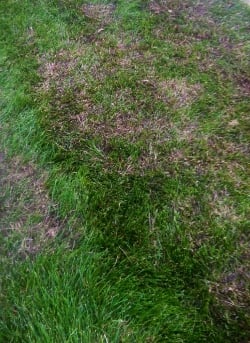October is one of my favorite months. The temperatures are crisp, the fall colors vivid and our cool-season lawns are looking their best. For homeowners in the northern half of the country, October provides a much needed rest from the summer lawn care battles. Yep, there’s nothing like a pristine carpet of green grass to… wait… what’s that brown purplish stuff intertwined in your lawn? While it might have been there all season, it’s only now that any bermudagrass in your lawn will start to stand out like a sore thumb. Don’t get me wrong, bermudagrass is an excellent choice for lawns in warm southern climates. Its adaptability is legendary. From sand to clay, from dry to humid, from foot traffic to sports fields,bermudagrass can handle it all while still looking great. However, it’s these same qualities that can make bermudagrass a nuisance in cool-season bluegrass, ryegrass and fescue lawns.
Bermudagrass Invasion
A bermudagrass invasion can be difficult to detect until it’s too late. As a warm-season grass, bermudagrass thrives during the hot summer months when temperatures reach 80+ degrees F. Unfortunately, it’s during this same time that cool-season grasses begin to slow down in their growth habit. This downtime provides a great opportunity for bermudagrass to start wandering into areas it shouldn’t. Come fall, bermudagrass will begin to go dormant and turn a dark purple or brown color. 
Prevention is Key
Like most situations in life, prevention is the best course of action. Bermudagrass is easily spread from contaminated soils, composts and low-quality seed blends. Make sure your sources for these materials are weed-free. Because bermudagrass can also spread vegetatively (the ability to grow a new plant from small pieces of the original plant), be aware that lawn care services can also spread bermudagrass through grass clippings and dirty equipment.
Cultural Practices for Avoiding Bermudagrass
There are also some cultural practices you can use to promote the growth of your cool-season grass while discouraging the growth of bermudagrass. A lush, healthy lawn is the best way to combat the spread of all types of weeds. First, mow your lawn slightly taller. A mowing height of 3-3 ½ inches will help shade out the bermudagrass. Shade is one of the greatest weaknesses of bermudagrass. Next, don’t apply fertilizer during the summer months. This is when bermudagrass is most active. Also, if your next door neighbor has a bermudagrass problem, be sure to install impenetrable barrier between your lawn and your neighbor’s lawn at least 6 inches deep to prevent the spread of bermudagrass rhizomes. Surface edging will also need to be put into place to stop the above-ground stolons.
How to Remove Bermudagrass

Chemical Solutions
As a last resort, chemicals can be used to kill the bermudagrass. A non-selective herbicide such as glyphosate can be applied to the bermudagrass while it’s actively growing in the summer. This should be applied 2-3 times, 3-4 weeks apart. Keep in mind this will kill all the grass it comes in contact with, so you’ll need to reseed the dead areas later. There are also some selective herbicides designed to kill bermudagrass without harming the cool-season grasses. Fenoxaprop, triclopyr and fluazifob are a few of these. Be sure to read the labels carefully and apply only as directed. Some of these selective herbicides should only be applied by professional lawn care technicians.





